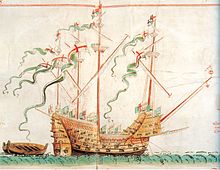Tudor navy
He also invested in dockyards and commissioned Sir Reginald Bray to construct a dry dock in 1495 at Portsmouth (the oldest surviving example),[2] with Sweepstake and Mary Fortune being the first ships built there in 1497.[dubious – discuss] It was the most powerful naval force to date in English history: 24 ships led by the 1600-ton "Henry Imperial"; the fleet carried 5000 combat marines and 3000 sailors.[11] He drained his treasury on military and naval affairs, diverting the revenues from new taxes and the sales of monastery lands as well as taking out foreign loans and debasing the English currency.In 1514 the 1,500-ton carrack Henry Grace à Dieu was launched, the first English two-decker and one of the earliest warships equipped with gunports and heavy bronze cannons.Henry VIII was threatened by the Pope's excommunication proceedings in 1538 and the peace between France and the Holy Roman Empire, which would allow them to unite against a heretical England.In the same year a memorandum established a "king's majesty's council of his marine", the first formal organization comprising seven officers, each in charge of a specific area, presided over by "Lieutenant of the Admiralty" or Vice-Admiral Thomas Clere.[16] This would later prove crucial to the growth and development of the race-built galleon and the Elizabethan Navy that would obtain some triumphs against the Spanish Armada during the war between Protestant England and Catholic Spain.[17] She risked war with Spain by supporting the "Sea Dogs," such as John Hawkins and Francis Drake, who preyed on the Spanish merchant ships carrying gold and silver from the New World.A fleet review on Elizabeth I's accession in 1559 showed the navy to consist of 39 ships, and there were plans to build another 30, to be grouped into five categories (a foreshadowing of the rating system).Henry VIII introduced gunports into the design of English warships; this saw naval guns being moved from the traditional high castles upon the deck to the lower waist of the ship, providing more stability and allowed for full broadsides.[24] When Spain finally decided to invade and conquer England it was a fiasco; Hawkins and Drake's designs of English warships made them longer, faster, more maneuverable, and more heavily gunned than its Spanish counterpart.[25] Officers from 1485 to 1546 included:[26] In 1546 Henry VIII establishes a Council of the Marine to oversee the administrative affairs of the Navy initially presided over by the Lieutenant of the Admiralty reporting to the Lord High Admiral.


carrackHenry Grace à DieuAnthony RollKingdom of EnglandTudor dynastyRoyal NavyHenry VIIdry dockPortsmouthRiver HambleJack ScarisbrickHenry VIIIHenry ImperialEdward HowardLord Admiralattacked on 10 August at Pointe Saint-MathieuRegentThomas Howardtwo-deckercannonsPepys Libraryblast furnacesshipwrightland troops to burn EdinburghLord LisleBattle of the SolentMary RoseLieutenant of the AdmiraltyThomas ClereG.R. EltonEdward VIMary ICalaisPhilip IISea DogsJohn HawkinsFrancis Drakefleet reviewElizabeth Irating systemElizabethDeptford DockyardprivateeringHawkinsCadiz raidPhilip II of SpainSpanish ArmadaAnglo-Spanish WarGracedieuMichaelfull-rigged shipDreadnoughtAdmiral of England, Ireland and AquitaineJohn de Vere, 13th Earl of OxfordSir Edward HowardThomas Howard, 3rd Duke of NorfolkHenry FitzRoy, 1st Duke of Richmond and SomersetWilliam Fitzwilliam, 1st Earl of SouthamptonJohn Russell, 1st Lord RussellJohn Dudley, 1st Viscount LisleClerk of Marine CausesRobert BrygandineWilliam GonsonSir Thomas SpertJohn WynterClerk Comptroller of the NavyThomas SpertThomas Seymour, 1st Lord Seymour of SudeleyJohn Dudley, 1st Earl of WarwickEdward Clinton, 9th Lord ClintonWilliam Howard, 1st Lord Howard of EffinghamEdward Clinton, 1st Earl of LincolnCharles Howard, 1st Earl of NottinghamCouncil of the MarineBenjamin GonsonFulke GrevilleWilliam WynterHenry PalmerJohn TrevorMasters of Naval OrdnanceWilliam WoodhouseThomas WyndhamComptrollers of the NavyVice-Admiral, William HolstockeWilliam BoroughSir Henry PalmerKeepers of the StorehousesSurveyors of Marine VictualsEdward BaesheMarmaduke DarrellAdmiralty in the 16th centuryNavy BoardWilliam Winter (admiral)Wayback MachineGeoffrey ParkerMariner's MirrorHistory TodayTanner, J. R.Corbett, Julian S.Konstam, AngusLoades, DavidRodger, Nicholas A. M.HistoryTimelineAnglo-Saxon EnglandHeptarchyNorman ConquestAnglo-NormansThe AnarchyAngevin EmpireEngland in the Late Middle AgesEconomy in the Middle AgesWars of the RosesTudor periodEnglish ReformationElizabethan eraEnglish RenaissanceStuart periodUnion of the CrownsGunpowder PlotJacobean eraCivil WarInterregnumCommonwealth of EnglandThe ProtectorateThe Restoration